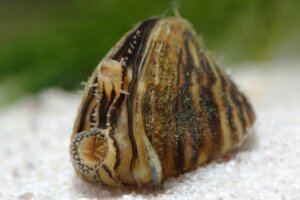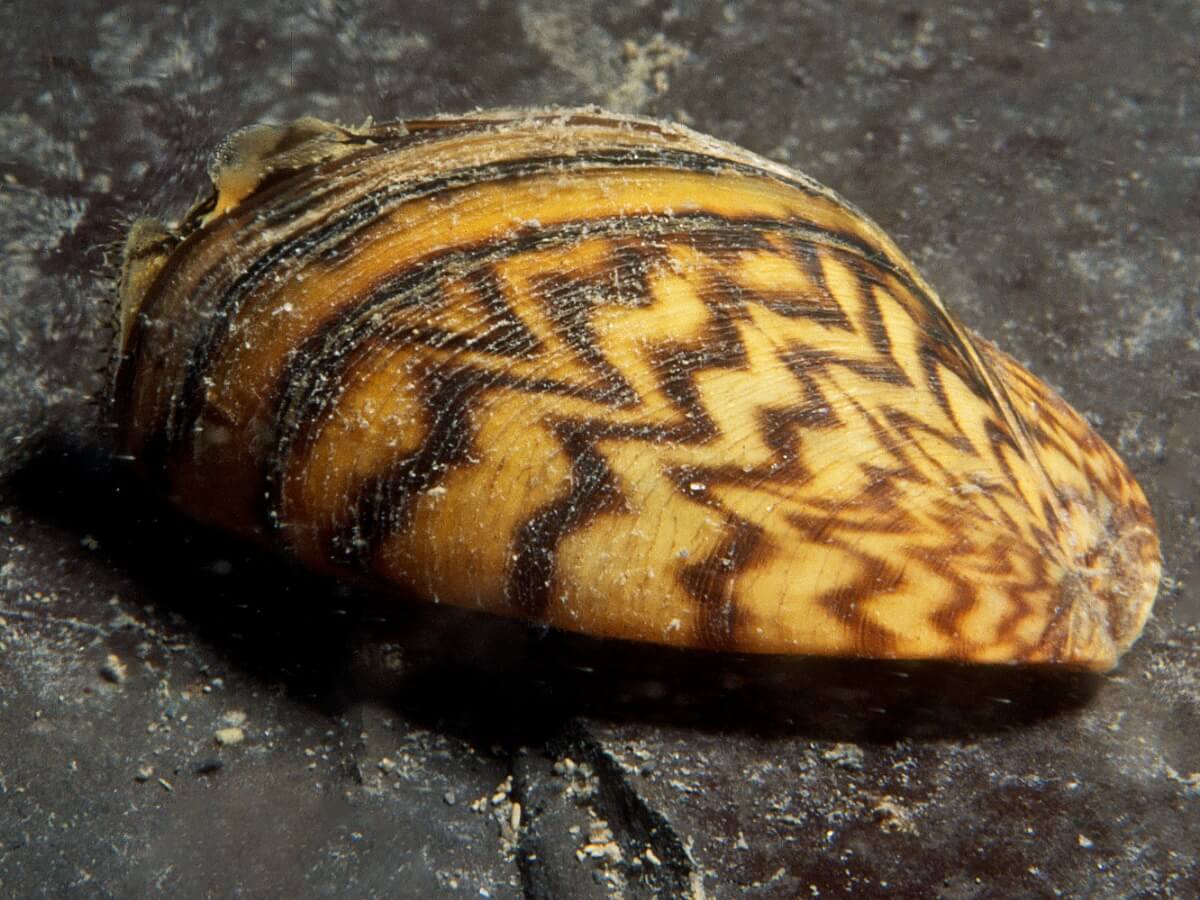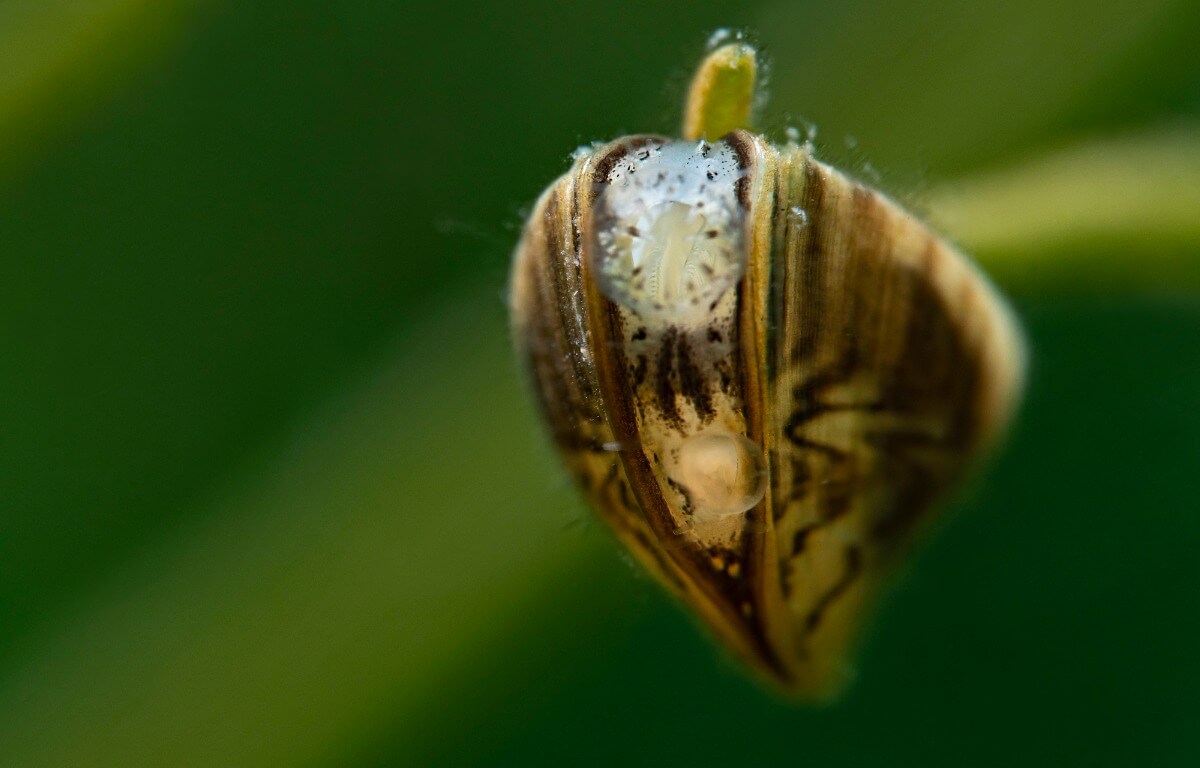Zebra Mussel: Characteristics of an Invasive Species


Written and verified by the biologist Francisco Morata Carramolino
When thinking of an invasive species, very conspicuous examples come to mind: the famous Argentine parrots, the American tortoises that infest Spanish rivers, or domestic cats. However, one of the most damaging invasive species seems much more insignificant: we’re talking here about the zebra mussel.
As a mussel, this invertebrate doesn’t move or hunt. Its only defense is its shell. Despite this, these animals are dangerous. They have an incredible ability to colonize ecosystems they don’t belong in. Ironically, they were once introduced by humans.
The consequences of the invasion of the zebra mussel are dire, both for indigenous nature and for humans, causing enormous economic losses. If you want to learn more about it, we invite you to continue reading.
What is the zebra mussel like?
The zebra mussel (Dreissena polymorpha) is a very small bivalve mollusk. It reaches a maximum of 3 centimeters (1.2 inches), although it’s usually smaller. The exact shape of its pattern, its colors and its shell are variable, hence its scientific name. Even so, some common characteristics of this invertebrate can be indicated.
The pattern is usually made up of light and dark irregular bands that are often zigzagged, but can be smooth. The dark ones are usually brown or black, the light ones are cream or pale.
On the other hand, the shell is more or less triangular, with two straighter sides and a rounded one. The umbo – the vertex that joins the 2 straight sides – is quite sharp. The other two vertices are much blunter.
Also, one of the straight sides is longer than the other. This side is thickened and flat, allowing the mussel to stand upright if placed on its side on a flat surface. This allows Dreissena polymorpha to be distinguished from other mussels.

Where does it come from?
This mollusk lives in fresh and brackish waters. Its natural distribution is limited to the basins of the Black Sea and the Caspian Sea, which lie in eastern Europe and border Asia.
However, its current distribution spans much of the globe and is constantly expanding. Today, the zebra mussel appears as an invasive species in the communities of Catalonia, La Rioja, Castilla y León, Aragon, Valencian Community, Navarra, the Basque Country and Andalusia, all within Spain.
This species has also been introduced into most European countries. Greece, France, Sweden, and Belgium are just a few examples. The same is true in the United States, where it has colonized most states, and in some areas of Canada.
As is characteristic of invasive species, the zebra mussel has spread throughout the world because of humans. In this case, the most likely culprit are boats.
Mussels have been transported from their natural areas in the ballast water of the boats or fixed on their different surfaces. Water transfers between river basins and for the transport of exotic fish have also contributed to the problem. Another vector to consider is contaminated equipment of all kinds.
These mussels have an enormous tolerance to the levels of salinity, temperature and desiccation. In addition, they are very resistant to chlorine. Therefore, they’re extraordinary colonizers.
As long as they have a hard surface to fix on and the availability of oxygen is adequate, mussels can reproduce and colonize wherever humans transport them. Undoubtedly, the resistance of this invertebrate is an ecosystem hazard outside its natural range.
Damage caused by the zebra mussel
Invasive species very severely damage the ecosystems they colonize, but these damages aren’t limited only to wildlife. Humans are also greatly affected by them. Next, we’ll show you why.
Human casualties
D. polymorpha is attached en masse to infrastructure and machinery of all kinds. Thus, it obstructs pipes, filters, engines, boats and tanks, among others. This harms the energy, agricultural, and tourism industries, in addition to making the supply of urban centers much more difficult. All of this causes significant economic losses.
These invertebrates are also found in recreational areas. Their shells are sharp and can cut, posing a public health hazard.
Environmental losses
These bivalves are highly efficient filter feeders that feed on plankton, the foundation of aquatic ecosystems. In doing so, they considerably transform the characteristics of these ecosystems.
Mussels increase the clarity of the water, modify the phosphorus cycles, increase the deposition of organic matter, and the proliferation of harmful bacteria and algae. They also decrease the availability of oxygen in aquatic ecosystems. All these alterations make the invaded environments less appropriate for indigenous life.
On the other hand, this bivalve mollusk causes the disappearance of native mussels through direct competition. Species such as Margaritifera auricularia, Anodonta cygnea, and Unio elongatulus are seriously endangered by the zebra mussel.
In addition, they also favor the transmission of pathogens to local fauna. Many birds have died from botulism – caused by a toxic bacteria – that comes from these mussels, as indicated by professional journalistic sources.

As has been proven, the zebra mussel is a very pernicious species. Its control is very important, but also very complicated. Therefore, as is always the case in these cases, the best strategy to avoid damage is to prevent potential invasive species from being introduced in the first place.
When thinking of an invasive species, very conspicuous examples come to mind: the famous Argentine parrots, the American tortoises that infest Spanish rivers, or domestic cats. However, one of the most damaging invasive species seems much more insignificant: we’re talking here about the zebra mussel.
As a mussel, this invertebrate doesn’t move or hunt. Its only defense is its shell. Despite this, these animals are dangerous. They have an incredible ability to colonize ecosystems they don’t belong in. Ironically, they were once introduced by humans.
The consequences of the invasion of the zebra mussel are dire, both for indigenous nature and for humans, causing enormous economic losses. If you want to learn more about it, we invite you to continue reading.
What is the zebra mussel like?
The zebra mussel (Dreissena polymorpha) is a very small bivalve mollusk. It reaches a maximum of 3 centimeters (1.2 inches), although it’s usually smaller. The exact shape of its pattern, its colors and its shell are variable, hence its scientific name. Even so, some common characteristics of this invertebrate can be indicated.
The pattern is usually made up of light and dark irregular bands that are often zigzagged, but can be smooth. The dark ones are usually brown or black, the light ones are cream or pale.
On the other hand, the shell is more or less triangular, with two straighter sides and a rounded one. The umbo – the vertex that joins the 2 straight sides – is quite sharp. The other two vertices are much blunter.
Also, one of the straight sides is longer than the other. This side is thickened and flat, allowing the mussel to stand upright if placed on its side on a flat surface. This allows Dreissena polymorpha to be distinguished from other mussels.

Where does it come from?
This mollusk lives in fresh and brackish waters. Its natural distribution is limited to the basins of the Black Sea and the Caspian Sea, which lie in eastern Europe and border Asia.
However, its current distribution spans much of the globe and is constantly expanding. Today, the zebra mussel appears as an invasive species in the communities of Catalonia, La Rioja, Castilla y León, Aragon, Valencian Community, Navarra, the Basque Country and Andalusia, all within Spain.
This species has also been introduced into most European countries. Greece, France, Sweden, and Belgium are just a few examples. The same is true in the United States, where it has colonized most states, and in some areas of Canada.
As is characteristic of invasive species, the zebra mussel has spread throughout the world because of humans. In this case, the most likely culprit are boats.
Mussels have been transported from their natural areas in the ballast water of the boats or fixed on their different surfaces. Water transfers between river basins and for the transport of exotic fish have also contributed to the problem. Another vector to consider is contaminated equipment of all kinds.
These mussels have an enormous tolerance to the levels of salinity, temperature and desiccation. In addition, they are very resistant to chlorine. Therefore, they’re extraordinary colonizers.
As long as they have a hard surface to fix on and the availability of oxygen is adequate, mussels can reproduce and colonize wherever humans transport them. Undoubtedly, the resistance of this invertebrate is an ecosystem hazard outside its natural range.
Damage caused by the zebra mussel
Invasive species very severely damage the ecosystems they colonize, but these damages aren’t limited only to wildlife. Humans are also greatly affected by them. Next, we’ll show you why.
Human casualties
D. polymorpha is attached en masse to infrastructure and machinery of all kinds. Thus, it obstructs pipes, filters, engines, boats and tanks, among others. This harms the energy, agricultural, and tourism industries, in addition to making the supply of urban centers much more difficult. All of this causes significant economic losses.
These invertebrates are also found in recreational areas. Their shells are sharp and can cut, posing a public health hazard.
Environmental losses
These bivalves are highly efficient filter feeders that feed on plankton, the foundation of aquatic ecosystems. In doing so, they considerably transform the characteristics of these ecosystems.
Mussels increase the clarity of the water, modify the phosphorus cycles, increase the deposition of organic matter, and the proliferation of harmful bacteria and algae. They also decrease the availability of oxygen in aquatic ecosystems. All these alterations make the invaded environments less appropriate for indigenous life.
On the other hand, this bivalve mollusk causes the disappearance of native mussels through direct competition. Species such as Margaritifera auricularia, Anodonta cygnea, and Unio elongatulus are seriously endangered by the zebra mussel.
In addition, they also favor the transmission of pathogens to local fauna. Many birds have died from botulism – caused by a toxic bacteria – that comes from these mussels, as indicated by professional journalistic sources.

As has been proven, the zebra mussel is a very pernicious species. Its control is very important, but also very complicated. Therefore, as is always the case in these cases, the best strategy to avoid damage is to prevent potential invasive species from being introduced in the first place.
All cited sources were thoroughly reviewed by our team to ensure their quality, reliability, currency, and validity. The bibliography of this article was considered reliable and of academic or scientific accuracy.
- Ministerio para la Transición Ecológica. 2013. Dreissena polymorpha (Pallas, 1771). Catálogo Español de Especies Exóticas Invasoras. https://www.miteco.gob.es/es/biodiversidad/temas/conservacion-de-especies/especies-exoticas-invasoras/ce_eei_invertebrados_na.aspx
- https://www.miteco.gob.es/es/biodiversidad/temas/conservacion-de-especies/dreissenapolymorphapallas1771_tcm30-436580.pdf
- https://www.treehugger.com/zebra-mussels-5115070
- https://www.cabi.org/isc/datasheet/85295
- https://www.uragentzia.euskadi.eus/u81-0003271/es/contenidos/informacion/invasoras_mejillon_cebra_2014/es_def/index.shtml
This text is provided for informational purposes only and does not replace consultation with a professional. If in doubt, consult your specialist.








